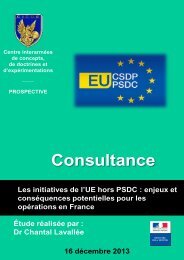Conference
science-research-bulletin-2013-conference
science-research-bulletin-2013-conference
Create successful ePaper yourself
Turn your PDF publications into a flip-book with our unique Google optimized e-Paper software.
EUROPEAN POLICE SCIENCE AND RESEARCH BULLETIN<br />
SPECIAL CONFERENCE EDITION<br />
vitally important mechanism insofar as it ‘creates<br />
the context for a better understanding, a greater<br />
chance of negotiated outcomes and protester<br />
compliance, and enhanced predictability for the<br />
parties involved’ (ibid.).<br />
These views chime with those of UK academics<br />
who, like the present author, have generally<br />
approved of recent attempts by British police<br />
forces to help ‘facilitate the right to protest’ by<br />
adopting communication-based tactics and<br />
strategies, based on seminal Swedish Dialogue<br />
Policing approaches (Gorringe et al., 2012;<br />
Gorringe and Rosie, 2013; Stott et al., 2013; D.<br />
Waddington, 2013). Such methods are consistent<br />
with official recommendations appearing in the<br />
wake of the controversial policing of the 2009<br />
G20 protest in central London (HMCIC, 2009a,<br />
2009b). On that occasion, the Metropolitan<br />
Police Service (MPS) were heavily criticised for<br />
using over-zealous tactics which saw hundreds<br />
of protesters ‘kettled’ (contained and detained)<br />
for several hours, and an innocent bystander<br />
(Ian Tomlinson) die of injuries sustained during<br />
an unwarranted assault by a police officer which<br />
only reached public attention when a ‘citizen<br />
journalist’ disclosed relevant video footage to The<br />
Guardian newspaper (Greer and McGlaughlin,<br />
2010; Rosie and Gorringe, 2009).<br />
This strong commitment to using effective<br />
communication and dialogue also underpins<br />
the GODIAC project (e.g. GODIAC, 2013), a<br />
European Union-funded initiative involving<br />
case studies of protest policing in nine separate<br />
nations, whose recommendations for a common<br />
European approach to policing ‘political<br />
manifestations’ firmly endorse the four key<br />
‘principles of conflict reduction’ identified by<br />
Reicher and his co-workers — namely: education<br />
(understanding the various ‘social identities’,<br />
values, beliefs and objectives of the different<br />
sections of the crowd); facilitation (striving to<br />
help protesters achieve their legitimate goals);<br />
communication (employing negotiation, prior<br />
to and during the event, with the intention<br />
of reaching agreements, and avoiding any<br />
misunderstandings or unpleasant surprises); and<br />
differentiation (resisting the inclination to treat<br />
all members of the crowd in uniform manner,<br />
irrespective of whether they are ‘guilty’ or<br />
‘innocent’) (Reicher et al. 2007).<br />
7What UK commentators in particular have not<br />
sufficiently emphasised is the degree to which<br />
this ‘new’ dialogue approach shares compelling<br />
similarities with the negotiation-oriented public<br />
order policing methods observed more than<br />
two decades ago by PAJ Waddington (1994) in<br />
his two-year study of the MPS. Waddington’s<br />
basic revelation that senior MPS public order<br />
commanders were apt to use various forms of<br />
‘guile’ and ‘interactional ploys’ in order to induce<br />
(or even outfox) protest organisers into staging<br />
their marches and demonstrations more in<br />
accordance with police interests and objectives<br />
than those of the protest participants is certainly<br />
of relevance to the issues raised by Baker. The<br />
following article seeks to addresses this important<br />
oversight by reopening discussion, first set out in<br />
D. Waddington (2013) and D. Waddington and<br />
McSeveny (2012), of the recent police operation<br />
implemented by South Yorkshire Police (SYP) in<br />
response to the anti-Lib Dem protest, staged in<br />
Sheffield city centre in March 2011.<br />
The first section of the article not only outlines<br />
the underlying principles and objectives of the<br />
Dialogue Policing approach, but also alludes to<br />
some of the possible difficulties associated with<br />
its practical application. The second section<br />
then summarises the main findings from PAJ<br />
Waddington’s important study of negotiationbased<br />
policing in the MPS. These initial sections<br />
will provide the context for a case study, spanning<br />
four further sections, of the composition, ethos,<br />
activities and ‘effectiveness’ of the Police Liaison<br />
Team employed by SYP at the anti-Lib Dem<br />
protest, of any problems the team encountered,<br />
and of its relations both with protesters and<br />
‘more conventional’ public order Police Support<br />
Units (PSU). This case study will form the basis of<br />
a concluding section, focusing on the extent to<br />
which the type of methods implemented by SYP<br />
represent a novel, safer and more enlightened<br />
form of protest policing, and constitute a genuine<br />
and sincere attempt by the police to facilitate the<br />
‘right to protest’.<br />
DIALOGUE POLICING:<br />
PRINCIPLES AND PROBLEMS<br />
The Swedish Dialogue Policing approach has<br />
been comprehensively outlined by Holgersson<br />
and Knutsson (2011). According to these<br />
authors, it involves an overall commitment to:<br />
(i) ensuring the facilitation of the demonstrators’<br />
legitimate goals, via self-policing if possible; (ii)<br />
using a ‘counterpart perspective’ to anticipate<br />
31





